Business and Business Environment: Types, Analysis in UK Retail Report
VerifiedAdded on 2021/01/02
|16
|4581
|268
Report
AI Summary
This report offers a comprehensive analysis of the business environment, examining various types of organizations such as private, public, and non-profit entities, exemplified by LEGO, the Bank of England, and UNICEF, respectively. It delves into organizational structures, including flat and functional models, and the key functions within businesses, such as marketing, human resource management, and finance. Furthermore, the report explores the external factors impacting the UK retail market using PESTLE, SWOT, and Porter's Five Forces analyses, providing insights into political, social, economic, technological, legal, and environmental influences. The study highlights the complexities of global organizational structures and their impact on business operations and decision-making processes, aiming to provide a thorough understanding of the business landscape and its challenges.

Business and business
environment
environment
Paraphrase This Document
Need a fresh take? Get an instant paraphrase of this document with our AI Paraphraser
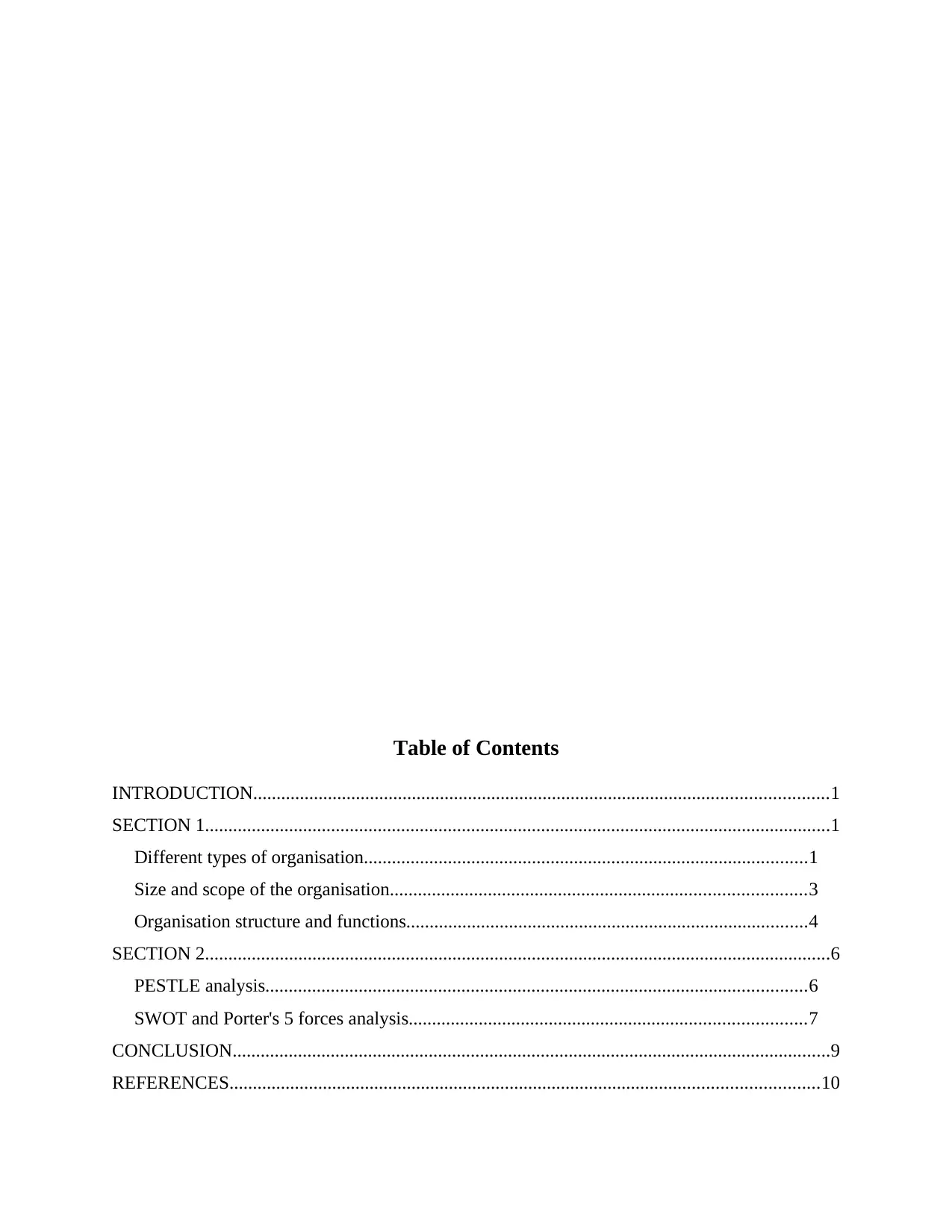
Table of Contents
INTRODUCTION...........................................................................................................................1
SECTION 1......................................................................................................................................1
Different types of organisation...............................................................................................1
Size and scope of the organisation.........................................................................................3
Organisation structure and functions......................................................................................4
SECTION 2......................................................................................................................................6
PESTLE analysis....................................................................................................................6
SWOT and Porter's 5 forces analysis.....................................................................................7
CONCLUSION................................................................................................................................9
REFERENCES..............................................................................................................................10
INTRODUCTION...........................................................................................................................1
SECTION 1......................................................................................................................................1
Different types of organisation...............................................................................................1
Size and scope of the organisation.........................................................................................3
Organisation structure and functions......................................................................................4
SECTION 2......................................................................................................................................6
PESTLE analysis....................................................................................................................6
SWOT and Porter's 5 forces analysis.....................................................................................7
CONCLUSION................................................................................................................................9
REFERENCES..............................................................................................................................10

⊘ This is a preview!⊘
Do you want full access?
Subscribe today to unlock all pages.

Trusted by 1+ million students worldwide

INTRODUCTION
A business can be defined as a trade and an occupation which includes various activities
of making money by purchasing and selling products. Business environment includes all the
external and internal factors that influence and impacts on the activities of business. It is very
important to develop an understanding about the business environment with the main aim of
identifying factors that may have impact business activities and then corrective actions. This
present report will focus on the different types of organisations and purpose of that type of
organisations (Prajogo, 2016). According to size and scope different types of organisations
follows different structure which plays an important role for them to play all the functions
effectively. This report will also show about the external factors that impacts on the activities of
UK retail markets such as Tesco, Sainsbury's, Mark & Spencers etc. Social, environmental,
political and technological factors and competitive analysis make companies able to analyse and
find out their strengths and weaknesses in order to remove weaknesses and take competitive
advantages.
SECTION 1
Different types of organisation
There are mainly three types of organisations such as profit or private, public and non for
profit and non-governmental organisations or voluntary organisation. These types of organisation
may be sole proprietorship, partnership and corporation.
LEGO: LEGO is privately hold company whose headquarter is in Billund, Denmark. It
manufactures and produces Lego brand plastic toys. It was founded in 1932 by OLE Kirk
Christiansen (Kauffmann, 2019).
Bank of England: It is the central bank of UK which was established on 27 July 1694.
Headquarter of this bank is in Threadneedle Street London, EC2. It is wholly owned by the
Treasury Solicitor (Bridges and et.al., 2016).
UNISEF: This fund and non-governmental or voluntary organisation created by the United
Nations General Assembly on 11 Dec 1946. It was created for providing emergency healthcare
and food to women & children in developing countries (Zadran and Kost, 2019).
1
A business can be defined as a trade and an occupation which includes various activities
of making money by purchasing and selling products. Business environment includes all the
external and internal factors that influence and impacts on the activities of business. It is very
important to develop an understanding about the business environment with the main aim of
identifying factors that may have impact business activities and then corrective actions. This
present report will focus on the different types of organisations and purpose of that type of
organisations (Prajogo, 2016). According to size and scope different types of organisations
follows different structure which plays an important role for them to play all the functions
effectively. This report will also show about the external factors that impacts on the activities of
UK retail markets such as Tesco, Sainsbury's, Mark & Spencers etc. Social, environmental,
political and technological factors and competitive analysis make companies able to analyse and
find out their strengths and weaknesses in order to remove weaknesses and take competitive
advantages.
SECTION 1
Different types of organisation
There are mainly three types of organisations such as profit or private, public and non for
profit and non-governmental organisations or voluntary organisation. These types of organisation
may be sole proprietorship, partnership and corporation.
LEGO: LEGO is privately hold company whose headquarter is in Billund, Denmark. It
manufactures and produces Lego brand plastic toys. It was founded in 1932 by OLE Kirk
Christiansen (Kauffmann, 2019).
Bank of England: It is the central bank of UK which was established on 27 July 1694.
Headquarter of this bank is in Threadneedle Street London, EC2. It is wholly owned by the
Treasury Solicitor (Bridges and et.al., 2016).
UNISEF: This fund and non-governmental or voluntary organisation created by the United
Nations General Assembly on 11 Dec 1946. It was created for providing emergency healthcare
and food to women & children in developing countries (Zadran and Kost, 2019).
1
Paraphrase This Document
Need a fresh take? Get an instant paraphrase of this document with our AI Paraphraser
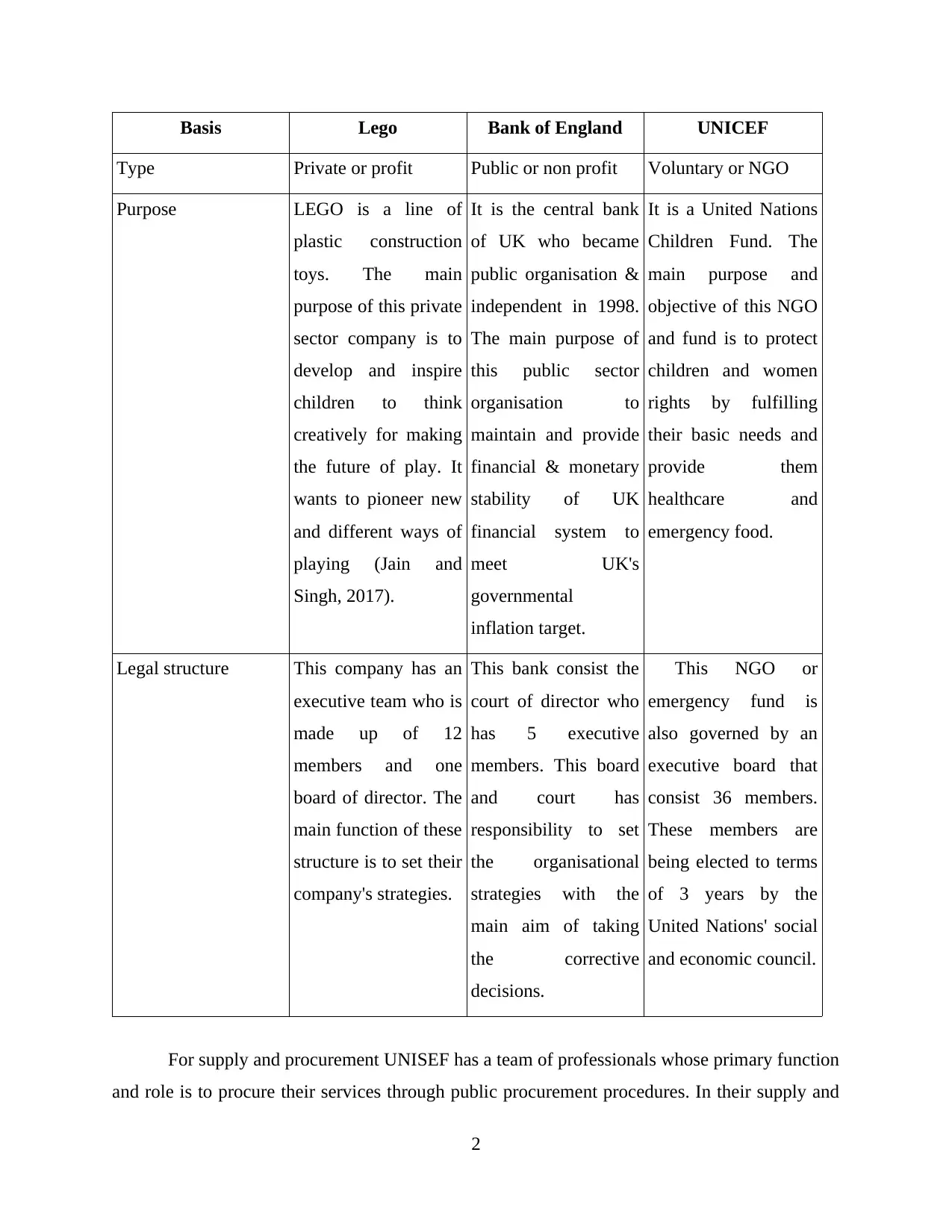
Basis Lego Bank of England UNICEF
Type Private or profit Public or non profit Voluntary or NGO
Purpose LEGO is a line of
plastic construction
toys. The main
purpose of this private
sector company is to
develop and inspire
children to think
creatively for making
the future of play. It
wants to pioneer new
and different ways of
playing (Jain and
Singh, 2017).
It is the central bank
of UK who became
public organisation &
independent in 1998.
The main purpose of
this public sector
organisation to
maintain and provide
financial & monetary
stability of UK
financial system to
meet UK's
governmental
inflation target.
It is a United Nations
Children Fund. The
main purpose and
objective of this NGO
and fund is to protect
children and women
rights by fulfilling
their basic needs and
provide them
healthcare and
emergency food.
Legal structure This company has an
executive team who is
made up of 12
members and one
board of director. The
main function of these
structure is to set their
company's strategies.
This bank consist the
court of director who
has 5 executive
members. This board
and court has
responsibility to set
the organisational
strategies with the
main aim of taking
the corrective
decisions.
This NGO or
emergency fund is
also governed by an
executive board that
consist 36 members.
These members are
being elected to terms
of 3 years by the
United Nations' social
and economic council.
For supply and procurement UNISEF has a team of professionals whose primary function
and role is to procure their services through public procurement procedures. In their supply and
2
Type Private or profit Public or non profit Voluntary or NGO
Purpose LEGO is a line of
plastic construction
toys. The main
purpose of this private
sector company is to
develop and inspire
children to think
creatively for making
the future of play. It
wants to pioneer new
and different ways of
playing (Jain and
Singh, 2017).
It is the central bank
of UK who became
public organisation &
independent in 1998.
The main purpose of
this public sector
organisation to
maintain and provide
financial & monetary
stability of UK
financial system to
meet UK's
governmental
inflation target.
It is a United Nations
Children Fund. The
main purpose and
objective of this NGO
and fund is to protect
children and women
rights by fulfilling
their basic needs and
provide them
healthcare and
emergency food.
Legal structure This company has an
executive team who is
made up of 12
members and one
board of director. The
main function of these
structure is to set their
company's strategies.
This bank consist the
court of director who
has 5 executive
members. This board
and court has
responsibility to set
the organisational
strategies with the
main aim of taking
the corrective
decisions.
This NGO or
emergency fund is
also governed by an
executive board that
consist 36 members.
These members are
being elected to terms
of 3 years by the
United Nations' social
and economic council.
For supply and procurement UNISEF has a team of professionals whose primary function
and role is to procure their services through public procurement procedures. In their supply and
2

procurement process they provide consultancy services, fun raising, event and public relation
services etc. Bank of England public sector organisation's activities make them able to fulfil their
responsibilities as the central bank of UK. It involves providing wholesale banking services and
financial stability to the UK government.
Size and scope of the organisation
Employees Businesses % of total businesses % of total private
employment
Small (10-49 employees) 177,950
businesses in
UK
14.30% 17.30%
Micro (1-9 employees) 1022695 82.30% 19.20%
Medium (50-249 employees) 29750 2.40% 14.50%
Large ( above 250) 6455 0.50% 48.60%
Private organisation: Sole proprietorship is a type of small business organisation who
has single owner. The owner has the liability against any claim. Private limited companies are
one who operates business at small level (Hillary, 2017). For example, Lego is a private limited
company and its consist of 19,000 employees who work at different location and in 42 offices.
An approx revenue of this company is 37.9 billion kr in the year of 2016. In the context of size
and scope, this company sold around 75 billion parts and 3,700 shapes. It has also launched its
335 new sets.
Large scale and public organisation: Bank of England is public limited and large
organisation. The size and scope of this large scale and public limited organisation can be
determined by the services which are being offered by it. According to the company law, this
public limited enterprises are required to employees at least 7 employees and can employees
maximum number of employees. It is important for large and public limited companies to
appoint at least or minimum two directors. This type of companies can issue their shares to
public. This type of companies have large number of operations and activities. For example,
3
services etc. Bank of England public sector organisation's activities make them able to fulfil their
responsibilities as the central bank of UK. It involves providing wholesale banking services and
financial stability to the UK government.
Size and scope of the organisation
Employees Businesses % of total businesses % of total private
employment
Small (10-49 employees) 177,950
businesses in
UK
14.30% 17.30%
Micro (1-9 employees) 1022695 82.30% 19.20%
Medium (50-249 employees) 29750 2.40% 14.50%
Large ( above 250) 6455 0.50% 48.60%
Private organisation: Sole proprietorship is a type of small business organisation who
has single owner. The owner has the liability against any claim. Private limited companies are
one who operates business at small level (Hillary, 2017). For example, Lego is a private limited
company and its consist of 19,000 employees who work at different location and in 42 offices.
An approx revenue of this company is 37.9 billion kr in the year of 2016. In the context of size
and scope, this company sold around 75 billion parts and 3,700 shapes. It has also launched its
335 new sets.
Large scale and public organisation: Bank of England is public limited and large
organisation. The size and scope of this large scale and public limited organisation can be
determined by the services which are being offered by it. According to the company law, this
public limited enterprises are required to employees at least 7 employees and can employees
maximum number of employees. It is important for large and public limited companies to
appoint at least or minimum two directors. This type of companies can issue their shares to
public. This type of companies have large number of operations and activities. For example,
3
⊘ This is a preview!⊘
Do you want full access?
Subscribe today to unlock all pages.

Trusted by 1+ million students worldwide
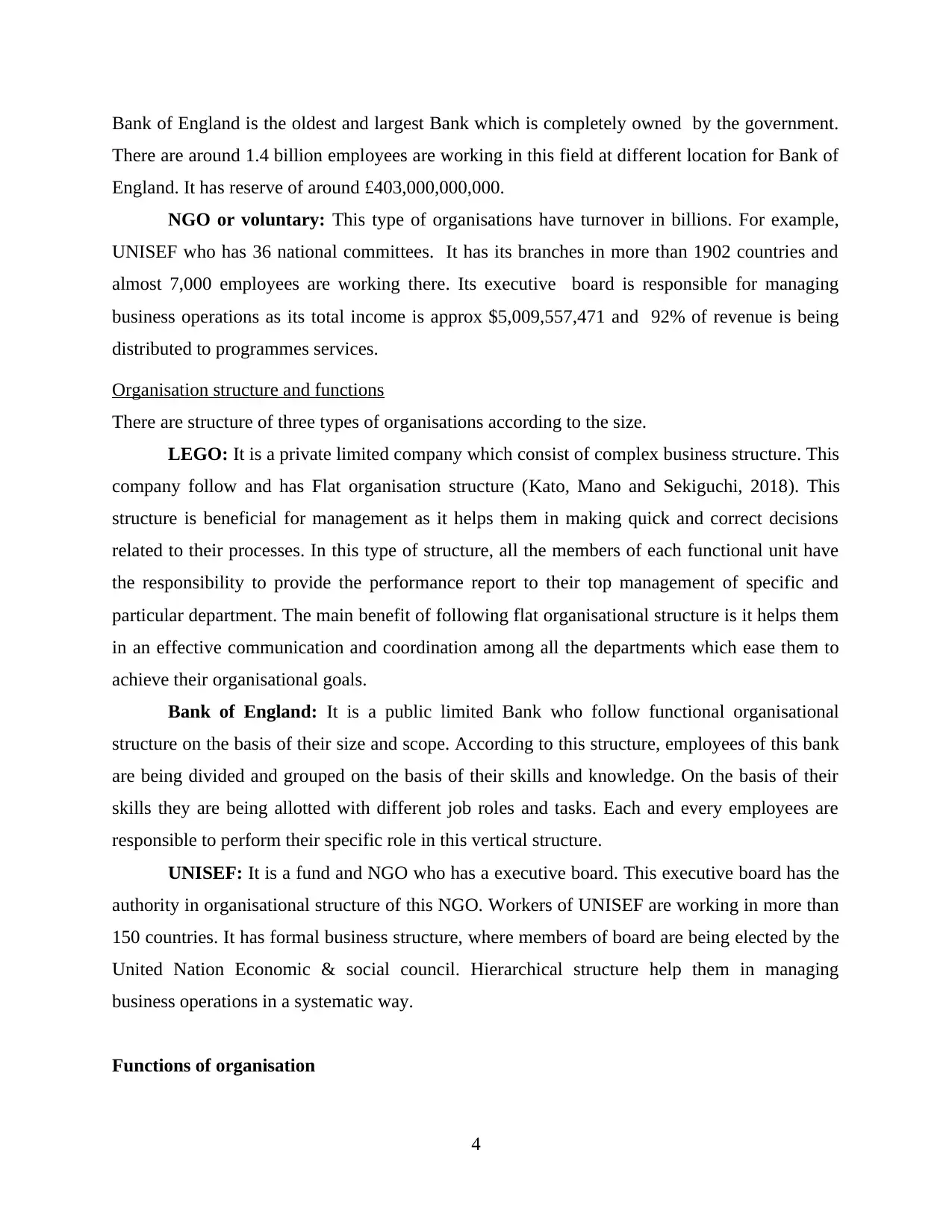
Bank of England is the oldest and largest Bank which is completely owned by the government.
There are around 1.4 billion employees are working in this field at different location for Bank of
England. It has reserve of around £403,000,000,000.
NGO or voluntary: This type of organisations have turnover in billions. For example,
UNISEF who has 36 national committees. It has its branches in more than 1902 countries and
almost 7,000 employees are working there. Its executive board is responsible for managing
business operations as its total income is approx $5,009,557,471 and 92% of revenue is being
distributed to programmes services.
Organisation structure and functions
There are structure of three types of organisations according to the size.
LEGO: It is a private limited company which consist of complex business structure. This
company follow and has Flat organisation structure (Kato, Mano and Sekiguchi, 2018). This
structure is beneficial for management as it helps them in making quick and correct decisions
related to their processes. In this type of structure, all the members of each functional unit have
the responsibility to provide the performance report to their top management of specific and
particular department. The main benefit of following flat organisational structure is it helps them
in an effective communication and coordination among all the departments which ease them to
achieve their organisational goals.
Bank of England: It is a public limited Bank who follow functional organisational
structure on the basis of their size and scope. According to this structure, employees of this bank
are being divided and grouped on the basis of their skills and knowledge. On the basis of their
skills they are being allotted with different job roles and tasks. Each and every employees are
responsible to perform their specific role in this vertical structure.
UNISEF: It is a fund and NGO who has a executive board. This executive board has the
authority in organisational structure of this NGO. Workers of UNISEF are working in more than
150 countries. It has formal business structure, where members of board are being elected by the
United Nation Economic & social council. Hierarchical structure help them in managing
business operations in a systematic way.
Functions of organisation
4
There are around 1.4 billion employees are working in this field at different location for Bank of
England. It has reserve of around £403,000,000,000.
NGO or voluntary: This type of organisations have turnover in billions. For example,
UNISEF who has 36 national committees. It has its branches in more than 1902 countries and
almost 7,000 employees are working there. Its executive board is responsible for managing
business operations as its total income is approx $5,009,557,471 and 92% of revenue is being
distributed to programmes services.
Organisation structure and functions
There are structure of three types of organisations according to the size.
LEGO: It is a private limited company which consist of complex business structure. This
company follow and has Flat organisation structure (Kato, Mano and Sekiguchi, 2018). This
structure is beneficial for management as it helps them in making quick and correct decisions
related to their processes. In this type of structure, all the members of each functional unit have
the responsibility to provide the performance report to their top management of specific and
particular department. The main benefit of following flat organisational structure is it helps them
in an effective communication and coordination among all the departments which ease them to
achieve their organisational goals.
Bank of England: It is a public limited Bank who follow functional organisational
structure on the basis of their size and scope. According to this structure, employees of this bank
are being divided and grouped on the basis of their skills and knowledge. On the basis of their
skills they are being allotted with different job roles and tasks. Each and every employees are
responsible to perform their specific role in this vertical structure.
UNISEF: It is a fund and NGO who has a executive board. This executive board has the
authority in organisational structure of this NGO. Workers of UNISEF are working in more than
150 countries. It has formal business structure, where members of board are being elected by the
United Nation Economic & social council. Hierarchical structure help them in managing
business operations in a systematic way.
Functions of organisation
4
Paraphrase This Document
Need a fresh take? Get an instant paraphrase of this document with our AI Paraphraser
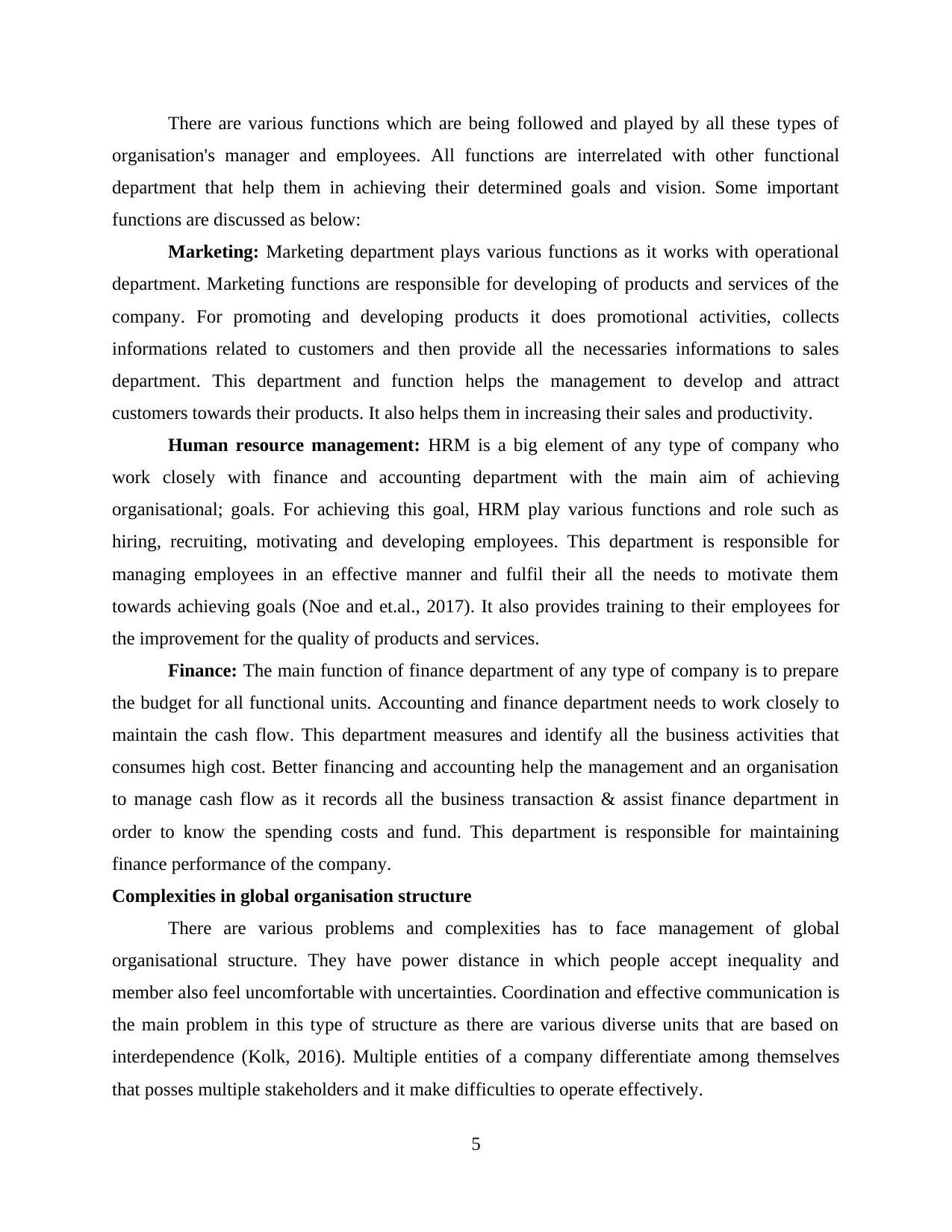
There are various functions which are being followed and played by all these types of
organisation's manager and employees. All functions are interrelated with other functional
department that help them in achieving their determined goals and vision. Some important
functions are discussed as below:
Marketing: Marketing department plays various functions as it works with operational
department. Marketing functions are responsible for developing of products and services of the
company. For promoting and developing products it does promotional activities, collects
informations related to customers and then provide all the necessaries informations to sales
department. This department and function helps the management to develop and attract
customers towards their products. It also helps them in increasing their sales and productivity.
Human resource management: HRM is a big element of any type of company who
work closely with finance and accounting department with the main aim of achieving
organisational; goals. For achieving this goal, HRM play various functions and role such as
hiring, recruiting, motivating and developing employees. This department is responsible for
managing employees in an effective manner and fulfil their all the needs to motivate them
towards achieving goals (Noe and et.al., 2017). It also provides training to their employees for
the improvement for the quality of products and services.
Finance: The main function of finance department of any type of company is to prepare
the budget for all functional units. Accounting and finance department needs to work closely to
maintain the cash flow. This department measures and identify all the business activities that
consumes high cost. Better financing and accounting help the management and an organisation
to manage cash flow as it records all the business transaction & assist finance department in
order to know the spending costs and fund. This department is responsible for maintaining
finance performance of the company.
Complexities in global organisation structure
There are various problems and complexities has to face management of global
organisational structure. They have power distance in which people accept inequality and
member also feel uncomfortable with uncertainties. Coordination and effective communication is
the main problem in this type of structure as there are various diverse units that are based on
interdependence (Kolk, 2016). Multiple entities of a company differentiate among themselves
that posses multiple stakeholders and it make difficulties to operate effectively.
5
organisation's manager and employees. All functions are interrelated with other functional
department that help them in achieving their determined goals and vision. Some important
functions are discussed as below:
Marketing: Marketing department plays various functions as it works with operational
department. Marketing functions are responsible for developing of products and services of the
company. For promoting and developing products it does promotional activities, collects
informations related to customers and then provide all the necessaries informations to sales
department. This department and function helps the management to develop and attract
customers towards their products. It also helps them in increasing their sales and productivity.
Human resource management: HRM is a big element of any type of company who
work closely with finance and accounting department with the main aim of achieving
organisational; goals. For achieving this goal, HRM play various functions and role such as
hiring, recruiting, motivating and developing employees. This department is responsible for
managing employees in an effective manner and fulfil their all the needs to motivate them
towards achieving goals (Noe and et.al., 2017). It also provides training to their employees for
the improvement for the quality of products and services.
Finance: The main function of finance department of any type of company is to prepare
the budget for all functional units. Accounting and finance department needs to work closely to
maintain the cash flow. This department measures and identify all the business activities that
consumes high cost. Better financing and accounting help the management and an organisation
to manage cash flow as it records all the business transaction & assist finance department in
order to know the spending costs and fund. This department is responsible for maintaining
finance performance of the company.
Complexities in global organisation structure
There are various problems and complexities has to face management of global
organisational structure. They have power distance in which people accept inequality and
member also feel uncomfortable with uncertainties. Coordination and effective communication is
the main problem in this type of structure as there are various diverse units that are based on
interdependence (Kolk, 2016). Multiple entities of a company differentiate among themselves
that posses multiple stakeholders and it make difficulties to operate effectively.
5
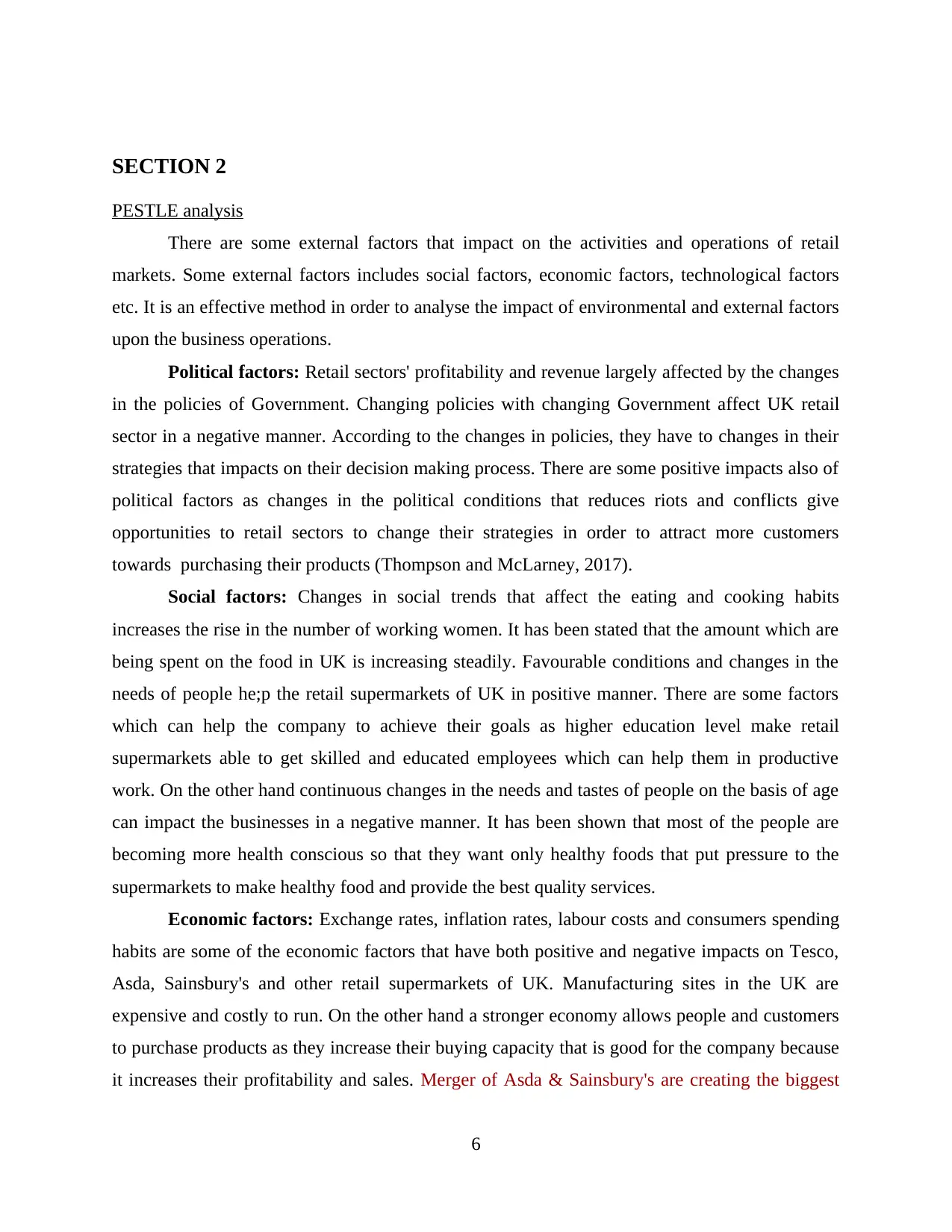
SECTION 2
PESTLE analysis
There are some external factors that impact on the activities and operations of retail
markets. Some external factors includes social factors, economic factors, technological factors
etc. It is an effective method in order to analyse the impact of environmental and external factors
upon the business operations.
Political factors: Retail sectors' profitability and revenue largely affected by the changes
in the policies of Government. Changing policies with changing Government affect UK retail
sector in a negative manner. According to the changes in policies, they have to changes in their
strategies that impacts on their decision making process. There are some positive impacts also of
political factors as changes in the political conditions that reduces riots and conflicts give
opportunities to retail sectors to change their strategies in order to attract more customers
towards purchasing their products (Thompson and McLarney, 2017).
Social factors: Changes in social trends that affect the eating and cooking habits
increases the rise in the number of working women. It has been stated that the amount which are
being spent on the food in UK is increasing steadily. Favourable conditions and changes in the
needs of people he;p the retail supermarkets of UK in positive manner. There are some factors
which can help the company to achieve their goals as higher education level make retail
supermarkets able to get skilled and educated employees which can help them in productive
work. On the other hand continuous changes in the needs and tastes of people on the basis of age
can impact the businesses in a negative manner. It has been shown that most of the people are
becoming more health conscious so that they want only healthy foods that put pressure to the
supermarkets to make healthy food and provide the best quality services.
Economic factors: Exchange rates, inflation rates, labour costs and consumers spending
habits are some of the economic factors that have both positive and negative impacts on Tesco,
Asda, Sainsbury's and other retail supermarkets of UK. Manufacturing sites in the UK are
expensive and costly to run. On the other hand a stronger economy allows people and customers
to purchase products as they increase their buying capacity that is good for the company because
it increases their profitability and sales. Merger of Asda & Sainsbury's are creating the biggest
6
PESTLE analysis
There are some external factors that impact on the activities and operations of retail
markets. Some external factors includes social factors, economic factors, technological factors
etc. It is an effective method in order to analyse the impact of environmental and external factors
upon the business operations.
Political factors: Retail sectors' profitability and revenue largely affected by the changes
in the policies of Government. Changing policies with changing Government affect UK retail
sector in a negative manner. According to the changes in policies, they have to changes in their
strategies that impacts on their decision making process. There are some positive impacts also of
political factors as changes in the political conditions that reduces riots and conflicts give
opportunities to retail sectors to change their strategies in order to attract more customers
towards purchasing their products (Thompson and McLarney, 2017).
Social factors: Changes in social trends that affect the eating and cooking habits
increases the rise in the number of working women. It has been stated that the amount which are
being spent on the food in UK is increasing steadily. Favourable conditions and changes in the
needs of people he;p the retail supermarkets of UK in positive manner. There are some factors
which can help the company to achieve their goals as higher education level make retail
supermarkets able to get skilled and educated employees which can help them in productive
work. On the other hand continuous changes in the needs and tastes of people on the basis of age
can impact the businesses in a negative manner. It has been shown that most of the people are
becoming more health conscious so that they want only healthy foods that put pressure to the
supermarkets to make healthy food and provide the best quality services.
Economic factors: Exchange rates, inflation rates, labour costs and consumers spending
habits are some of the economic factors that have both positive and negative impacts on Tesco,
Asda, Sainsbury's and other retail supermarkets of UK. Manufacturing sites in the UK are
expensive and costly to run. On the other hand a stronger economy allows people and customers
to purchase products as they increase their buying capacity that is good for the company because
it increases their profitability and sales. Merger of Asda & Sainsbury's are creating the biggest
6
⊘ This is a preview!⊘
Do you want full access?
Subscribe today to unlock all pages.

Trusted by 1+ million students worldwide
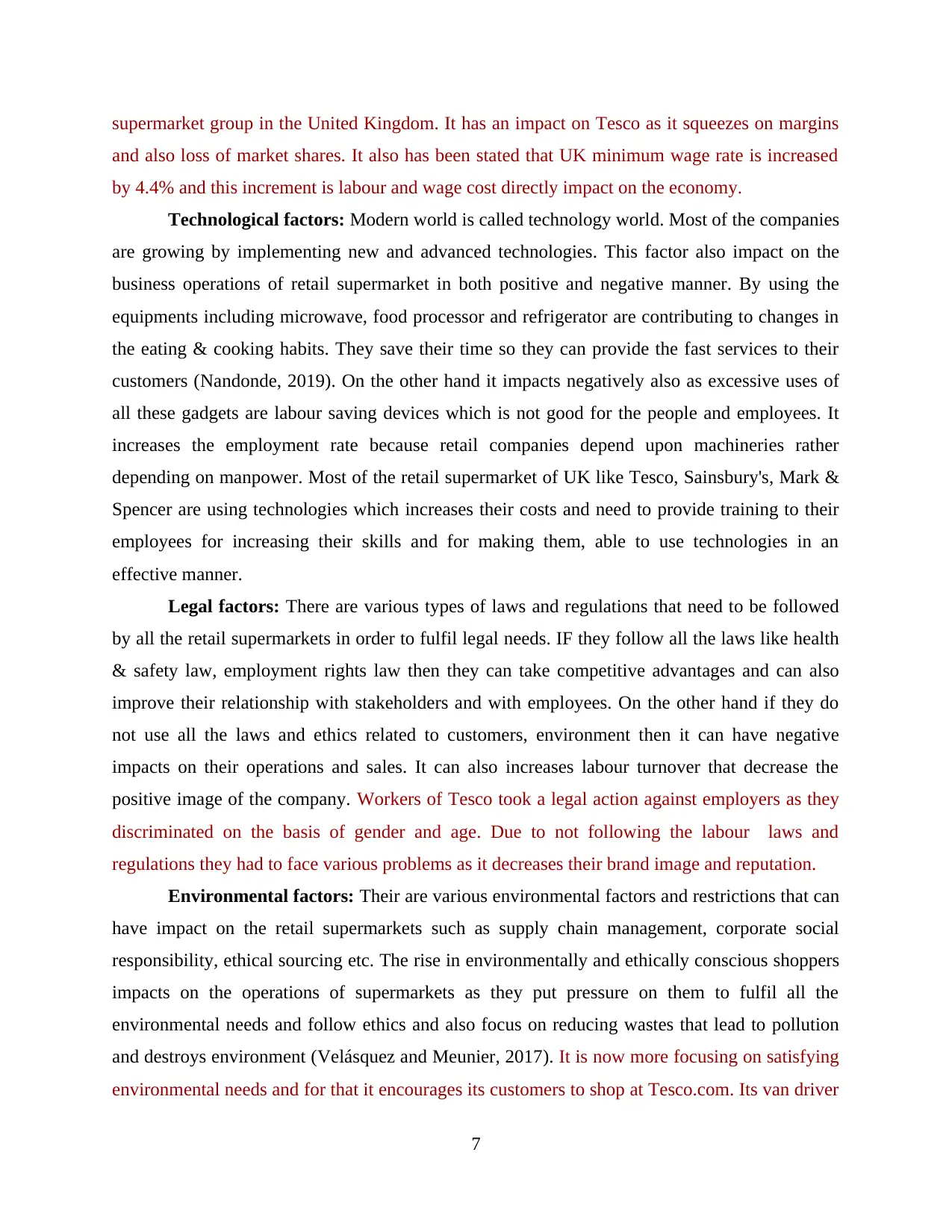
supermarket group in the United Kingdom. It has an impact on Tesco as it squeezes on margins
and also loss of market shares. It also has been stated that UK minimum wage rate is increased
by 4.4% and this increment is labour and wage cost directly impact on the economy.
Technological factors: Modern world is called technology world. Most of the companies
are growing by implementing new and advanced technologies. This factor also impact on the
business operations of retail supermarket in both positive and negative manner. By using the
equipments including microwave, food processor and refrigerator are contributing to changes in
the eating & cooking habits. They save their time so they can provide the fast services to their
customers (Nandonde, 2019). On the other hand it impacts negatively also as excessive uses of
all these gadgets are labour saving devices which is not good for the people and employees. It
increases the employment rate because retail companies depend upon machineries rather
depending on manpower. Most of the retail supermarket of UK like Tesco, Sainsbury's, Mark &
Spencer are using technologies which increases their costs and need to provide training to their
employees for increasing their skills and for making them, able to use technologies in an
effective manner.
Legal factors: There are various types of laws and regulations that need to be followed
by all the retail supermarkets in order to fulfil legal needs. IF they follow all the laws like health
& safety law, employment rights law then they can take competitive advantages and can also
improve their relationship with stakeholders and with employees. On the other hand if they do
not use all the laws and ethics related to customers, environment then it can have negative
impacts on their operations and sales. It can also increases labour turnover that decrease the
positive image of the company. Workers of Tesco took a legal action against employers as they
discriminated on the basis of gender and age. Due to not following the labour laws and
regulations they had to face various problems as it decreases their brand image and reputation.
Environmental factors: Their are various environmental factors and restrictions that can
have impact on the retail supermarkets such as supply chain management, corporate social
responsibility, ethical sourcing etc. The rise in environmentally and ethically conscious shoppers
impacts on the operations of supermarkets as they put pressure on them to fulfil all the
environmental needs and follow ethics and also focus on reducing wastes that lead to pollution
and destroys environment (Velásquez and Meunier, 2017). It is now more focusing on satisfying
environmental needs and for that it encourages its customers to shop at Tesco.com. Its van driver
7
and also loss of market shares. It also has been stated that UK minimum wage rate is increased
by 4.4% and this increment is labour and wage cost directly impact on the economy.
Technological factors: Modern world is called technology world. Most of the companies
are growing by implementing new and advanced technologies. This factor also impact on the
business operations of retail supermarket in both positive and negative manner. By using the
equipments including microwave, food processor and refrigerator are contributing to changes in
the eating & cooking habits. They save their time so they can provide the fast services to their
customers (Nandonde, 2019). On the other hand it impacts negatively also as excessive uses of
all these gadgets are labour saving devices which is not good for the people and employees. It
increases the employment rate because retail companies depend upon machineries rather
depending on manpower. Most of the retail supermarket of UK like Tesco, Sainsbury's, Mark &
Spencer are using technologies which increases their costs and need to provide training to their
employees for increasing their skills and for making them, able to use technologies in an
effective manner.
Legal factors: There are various types of laws and regulations that need to be followed
by all the retail supermarkets in order to fulfil legal needs. IF they follow all the laws like health
& safety law, employment rights law then they can take competitive advantages and can also
improve their relationship with stakeholders and with employees. On the other hand if they do
not use all the laws and ethics related to customers, environment then it can have negative
impacts on their operations and sales. It can also increases labour turnover that decrease the
positive image of the company. Workers of Tesco took a legal action against employers as they
discriminated on the basis of gender and age. Due to not following the labour laws and
regulations they had to face various problems as it decreases their brand image and reputation.
Environmental factors: Their are various environmental factors and restrictions that can
have impact on the retail supermarkets such as supply chain management, corporate social
responsibility, ethical sourcing etc. The rise in environmentally and ethically conscious shoppers
impacts on the operations of supermarkets as they put pressure on them to fulfil all the
environmental needs and follow ethics and also focus on reducing wastes that lead to pollution
and destroys environment (Velásquez and Meunier, 2017). It is now more focusing on satisfying
environmental needs and for that it encourages its customers to shop at Tesco.com. Its van driver
7
Paraphrase This Document
Need a fresh take? Get an instant paraphrase of this document with our AI Paraphraser
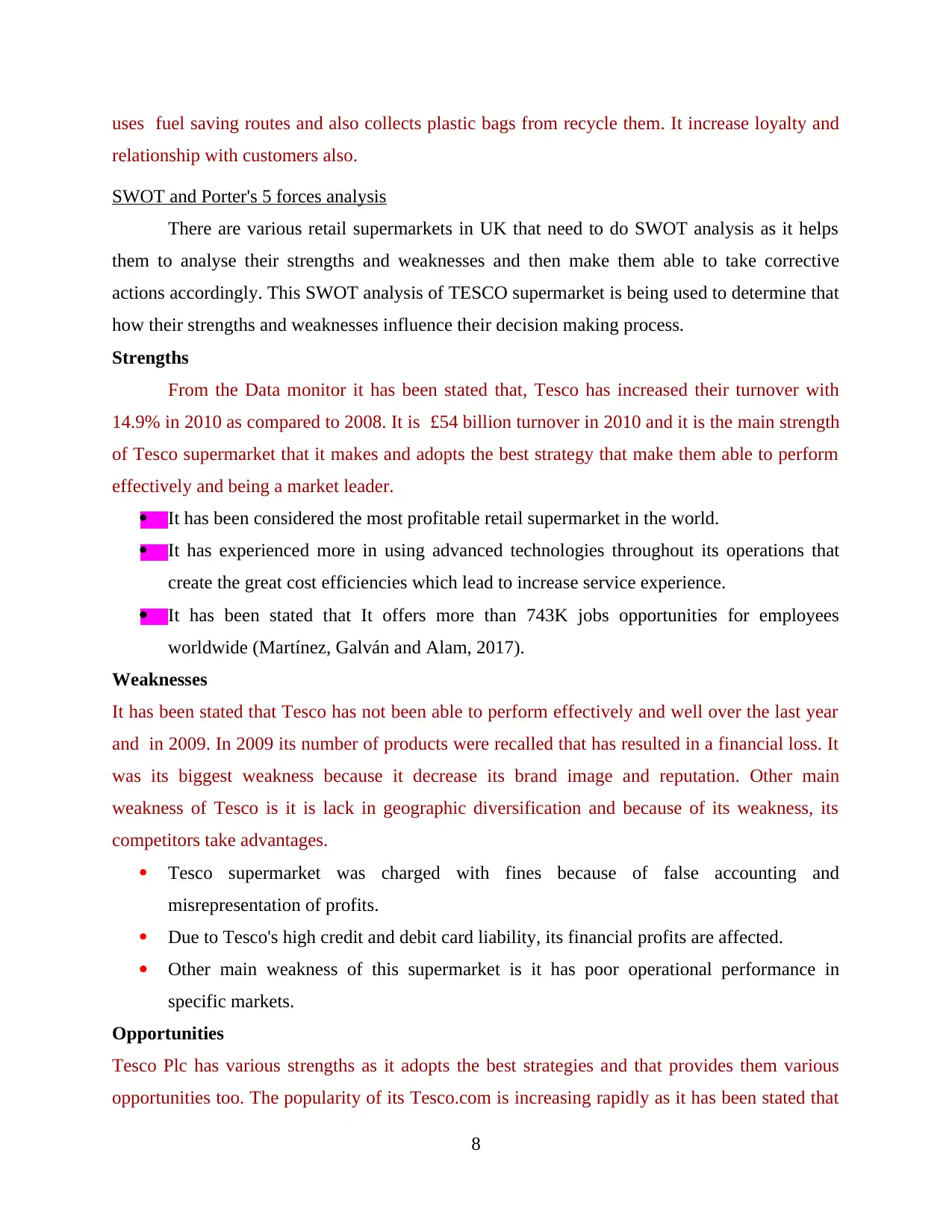
uses fuel saving routes and also collects plastic bags from recycle them. It increase loyalty and
relationship with customers also.
SWOT and Porter's 5 forces analysis
There are various retail supermarkets in UK that need to do SWOT analysis as it helps
them to analyse their strengths and weaknesses and then make them able to take corrective
actions accordingly. This SWOT analysis of TESCO supermarket is being used to determine that
how their strengths and weaknesses influence their decision making process.
Strengths
From the Data monitor it has been stated that, Tesco has increased their turnover with
14.9% in 2010 as compared to 2008. It is £54 billion turnover in 2010 and it is the main strength
of Tesco supermarket that it makes and adopts the best strategy that make them able to perform
effectively and being a market leader.
It has been considered the most profitable retail supermarket in the world.
It has experienced more in using advanced technologies throughout its operations that
create the great cost efficiencies which lead to increase service experience.
It has been stated that It offers more than 743K jobs opportunities for employees
worldwide (Martínez, Galván and Alam, 2017).
Weaknesses
It has been stated that Tesco has not been able to perform effectively and well over the last year
and in 2009. In 2009 its number of products were recalled that has resulted in a financial loss. It
was its biggest weakness because it decrease its brand image and reputation. Other main
weakness of Tesco is it is lack in geographic diversification and because of its weakness, its
competitors take advantages.
Tesco supermarket was charged with fines because of false accounting and
misrepresentation of profits.
Due to Tesco's high credit and debit card liability, its financial profits are affected.
Other main weakness of this supermarket is it has poor operational performance in
specific markets.
Opportunities
Tesco Plc has various strengths as it adopts the best strategies and that provides them various
opportunities too. The popularity of its Tesco.com is increasing rapidly as it has been stated that
8
relationship with customers also.
SWOT and Porter's 5 forces analysis
There are various retail supermarkets in UK that need to do SWOT analysis as it helps
them to analyse their strengths and weaknesses and then make them able to take corrective
actions accordingly. This SWOT analysis of TESCO supermarket is being used to determine that
how their strengths and weaknesses influence their decision making process.
Strengths
From the Data monitor it has been stated that, Tesco has increased their turnover with
14.9% in 2010 as compared to 2008. It is £54 billion turnover in 2010 and it is the main strength
of Tesco supermarket that it makes and adopts the best strategy that make them able to perform
effectively and being a market leader.
It has been considered the most profitable retail supermarket in the world.
It has experienced more in using advanced technologies throughout its operations that
create the great cost efficiencies which lead to increase service experience.
It has been stated that It offers more than 743K jobs opportunities for employees
worldwide (Martínez, Galván and Alam, 2017).
Weaknesses
It has been stated that Tesco has not been able to perform effectively and well over the last year
and in 2009. In 2009 its number of products were recalled that has resulted in a financial loss. It
was its biggest weakness because it decrease its brand image and reputation. Other main
weakness of Tesco is it is lack in geographic diversification and because of its weakness, its
competitors take advantages.
Tesco supermarket was charged with fines because of false accounting and
misrepresentation of profits.
Due to Tesco's high credit and debit card liability, its financial profits are affected.
Other main weakness of this supermarket is it has poor operational performance in
specific markets.
Opportunities
Tesco Plc has various strengths as it adopts the best strategies and that provides them various
opportunities too. The popularity of its Tesco.com is increasing rapidly as it has been stated that
8
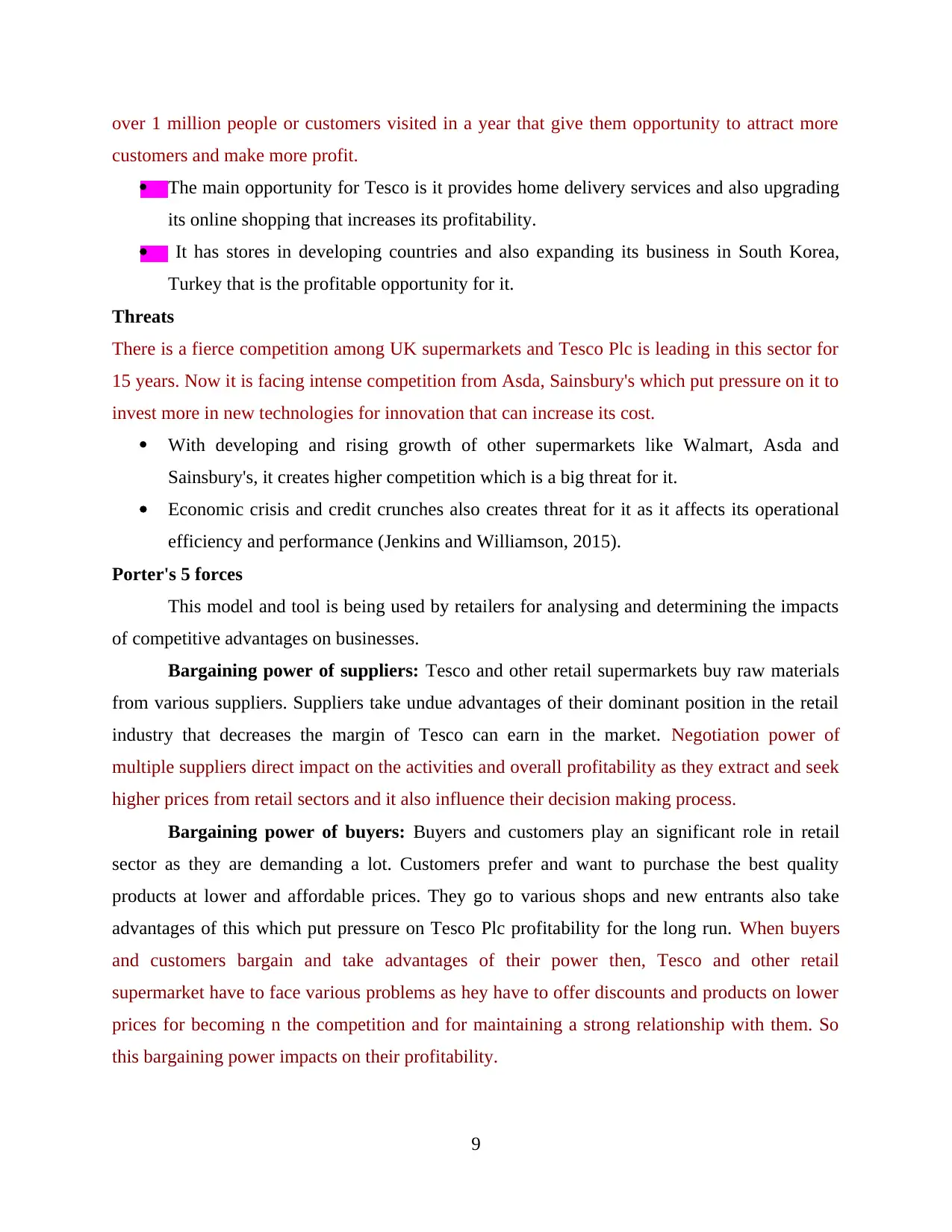
over 1 million people or customers visited in a year that give them opportunity to attract more
customers and make more profit.
The main opportunity for Tesco is it provides home delivery services and also upgrading
its online shopping that increases its profitability.
It has stores in developing countries and also expanding its business in South Korea,
Turkey that is the profitable opportunity for it.
Threats
There is a fierce competition among UK supermarkets and Tesco Plc is leading in this sector for
15 years. Now it is facing intense competition from Asda, Sainsbury's which put pressure on it to
invest more in new technologies for innovation that can increase its cost.
With developing and rising growth of other supermarkets like Walmart, Asda and
Sainsbury's, it creates higher competition which is a big threat for it.
Economic crisis and credit crunches also creates threat for it as it affects its operational
efficiency and performance (Jenkins and Williamson, 2015).
Porter's 5 forces
This model and tool is being used by retailers for analysing and determining the impacts
of competitive advantages on businesses.
Bargaining power of suppliers: Tesco and other retail supermarkets buy raw materials
from various suppliers. Suppliers take undue advantages of their dominant position in the retail
industry that decreases the margin of Tesco can earn in the market. Negotiation power of
multiple suppliers direct impact on the activities and overall profitability as they extract and seek
higher prices from retail sectors and it also influence their decision making process.
Bargaining power of buyers: Buyers and customers play an significant role in retail
sector as they are demanding a lot. Customers prefer and want to purchase the best quality
products at lower and affordable prices. They go to various shops and new entrants also take
advantages of this which put pressure on Tesco Plc profitability for the long run. When buyers
and customers bargain and take advantages of their power then, Tesco and other retail
supermarket have to face various problems as hey have to offer discounts and products on lower
prices for becoming n the competition and for maintaining a strong relationship with them. So
this bargaining power impacts on their profitability.
9
customers and make more profit.
The main opportunity for Tesco is it provides home delivery services and also upgrading
its online shopping that increases its profitability.
It has stores in developing countries and also expanding its business in South Korea,
Turkey that is the profitable opportunity for it.
Threats
There is a fierce competition among UK supermarkets and Tesco Plc is leading in this sector for
15 years. Now it is facing intense competition from Asda, Sainsbury's which put pressure on it to
invest more in new technologies for innovation that can increase its cost.
With developing and rising growth of other supermarkets like Walmart, Asda and
Sainsbury's, it creates higher competition which is a big threat for it.
Economic crisis and credit crunches also creates threat for it as it affects its operational
efficiency and performance (Jenkins and Williamson, 2015).
Porter's 5 forces
This model and tool is being used by retailers for analysing and determining the impacts
of competitive advantages on businesses.
Bargaining power of suppliers: Tesco and other retail supermarkets buy raw materials
from various suppliers. Suppliers take undue advantages of their dominant position in the retail
industry that decreases the margin of Tesco can earn in the market. Negotiation power of
multiple suppliers direct impact on the activities and overall profitability as they extract and seek
higher prices from retail sectors and it also influence their decision making process.
Bargaining power of buyers: Buyers and customers play an significant role in retail
sector as they are demanding a lot. Customers prefer and want to purchase the best quality
products at lower and affordable prices. They go to various shops and new entrants also take
advantages of this which put pressure on Tesco Plc profitability for the long run. When buyers
and customers bargain and take advantages of their power then, Tesco and other retail
supermarket have to face various problems as hey have to offer discounts and products on lower
prices for becoming n the competition and for maintaining a strong relationship with them. So
this bargaining power impacts on their profitability.
9
⊘ This is a preview!⊘
Do you want full access?
Subscribe today to unlock all pages.

Trusted by 1+ million students worldwide
1 out of 16
Related Documents
Your All-in-One AI-Powered Toolkit for Academic Success.
+13062052269
info@desklib.com
Available 24*7 on WhatsApp / Email
![[object Object]](/_next/static/media/star-bottom.7253800d.svg)
Unlock your academic potential
Copyright © 2020–2025 A2Z Services. All Rights Reserved. Developed and managed by ZUCOL.





